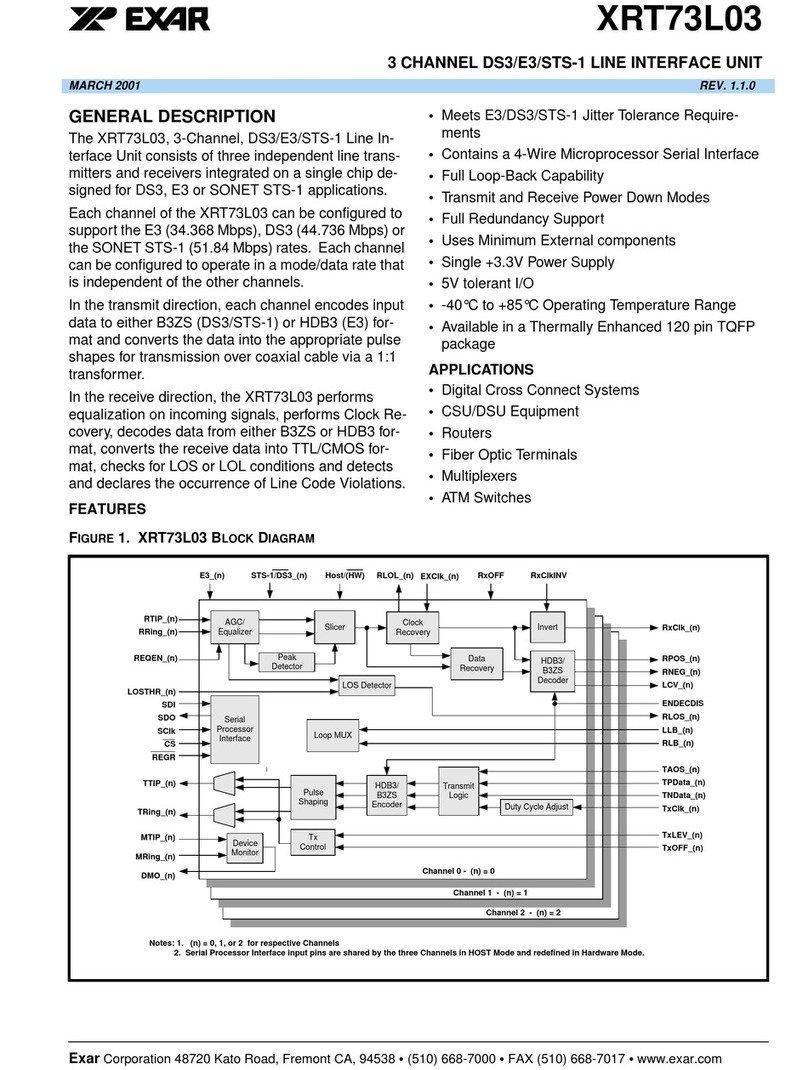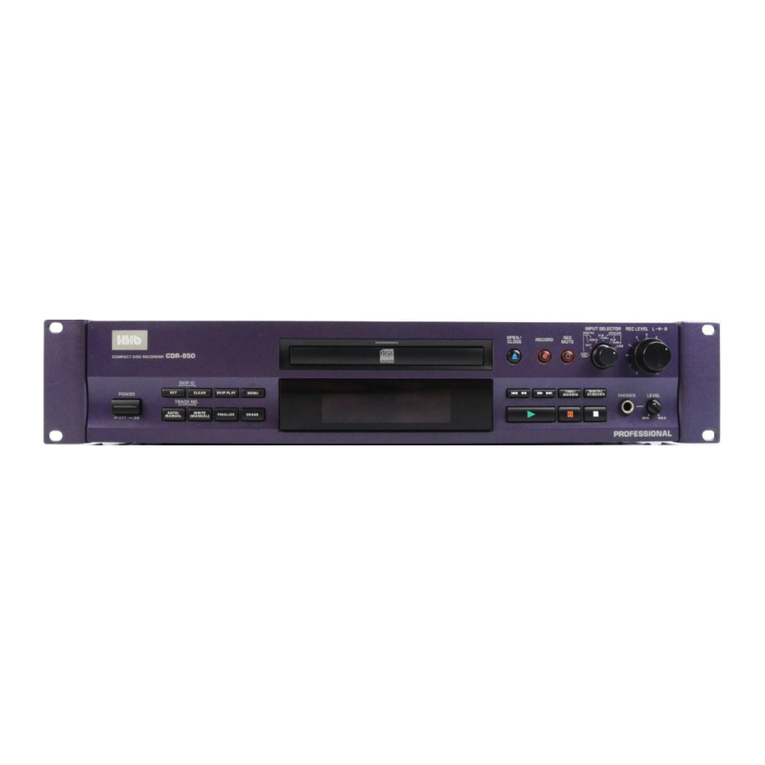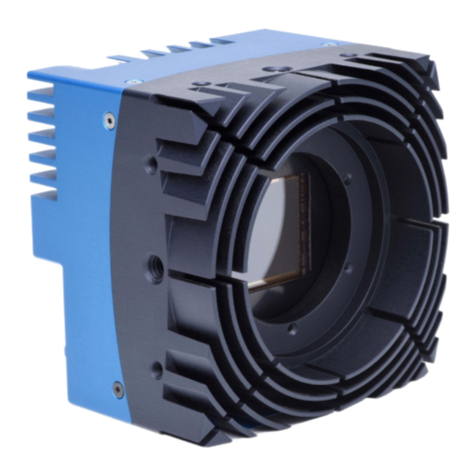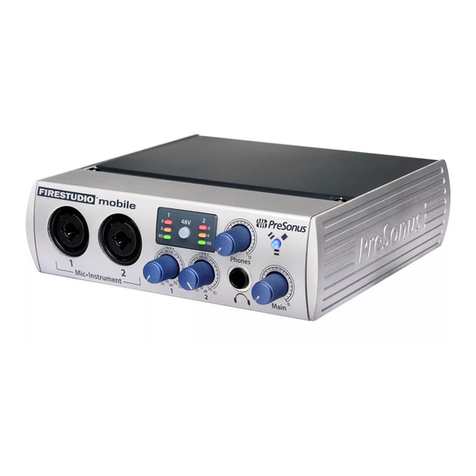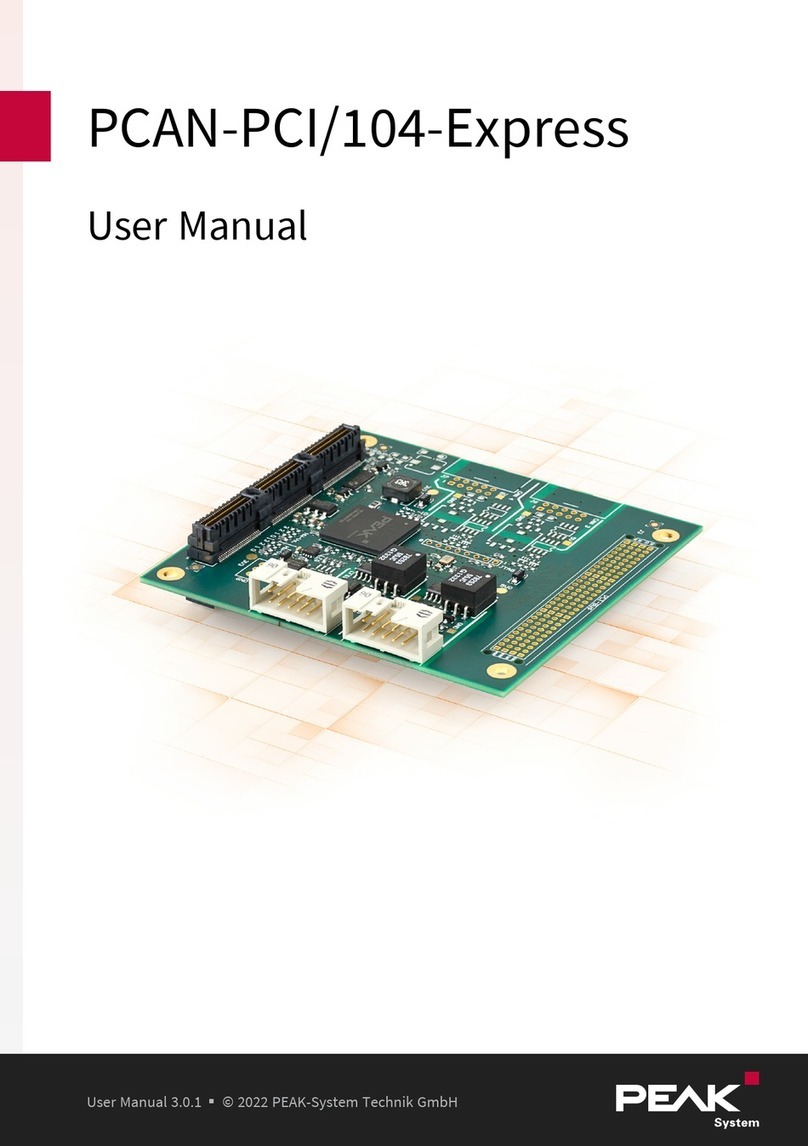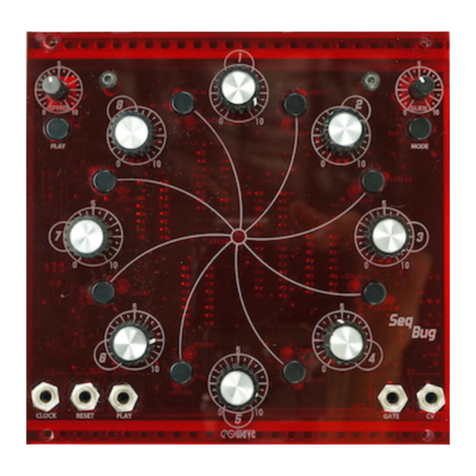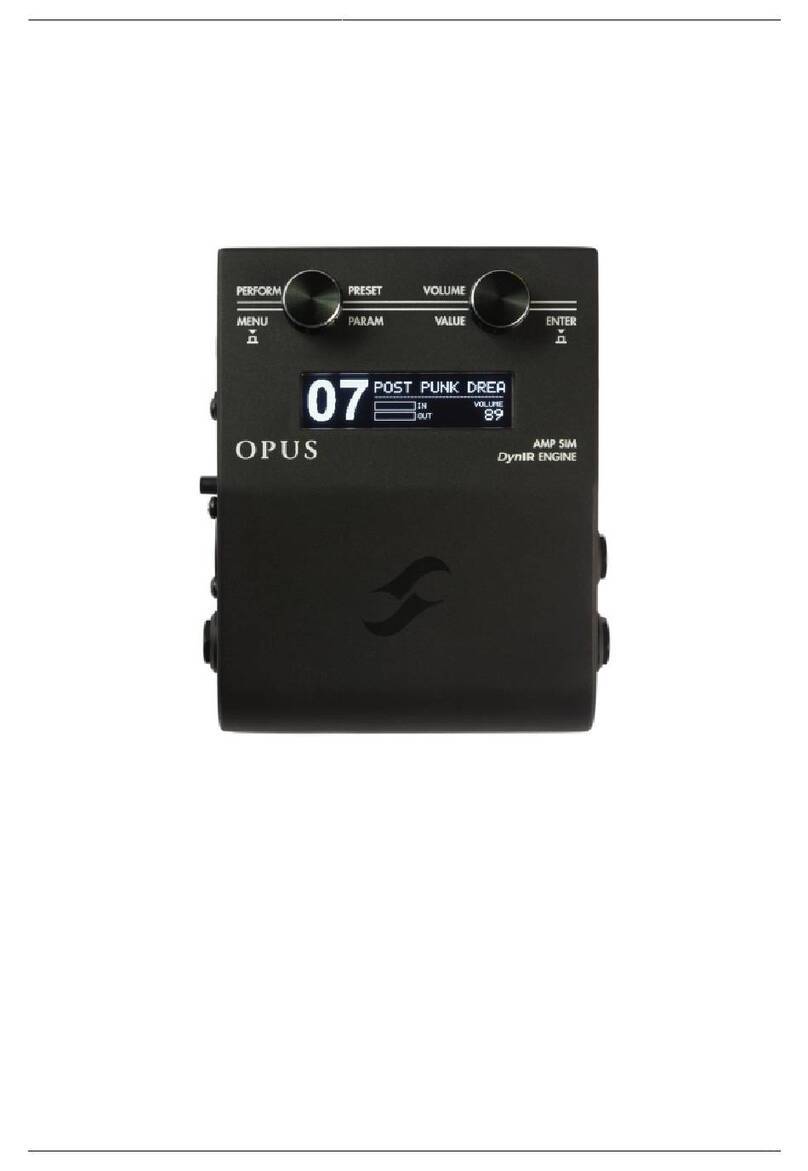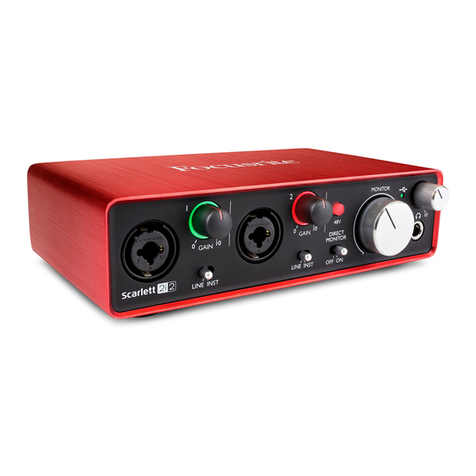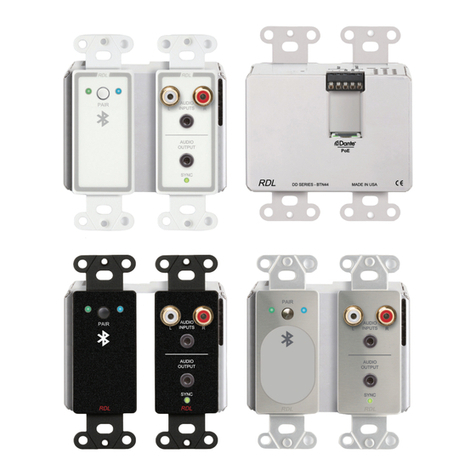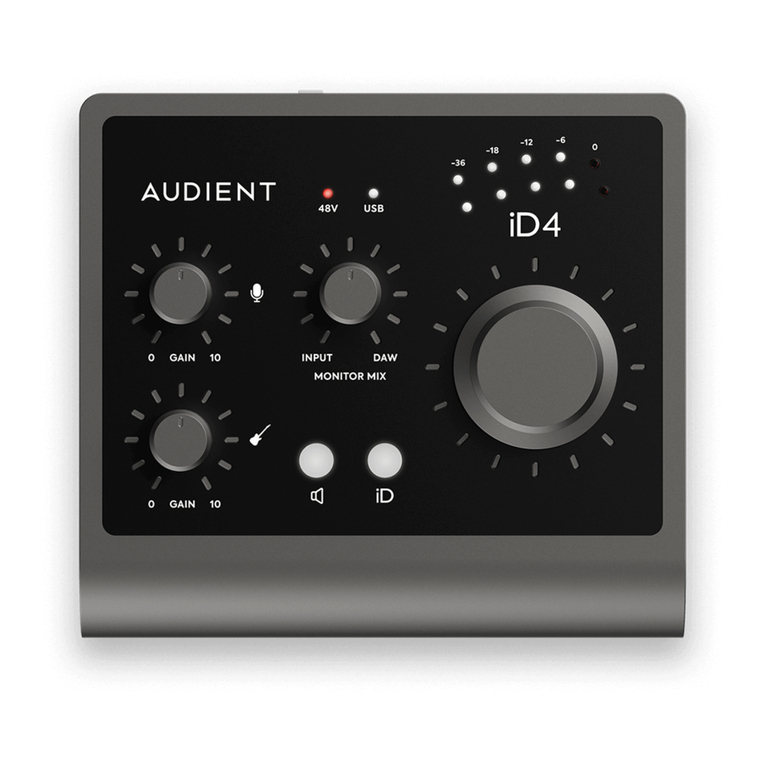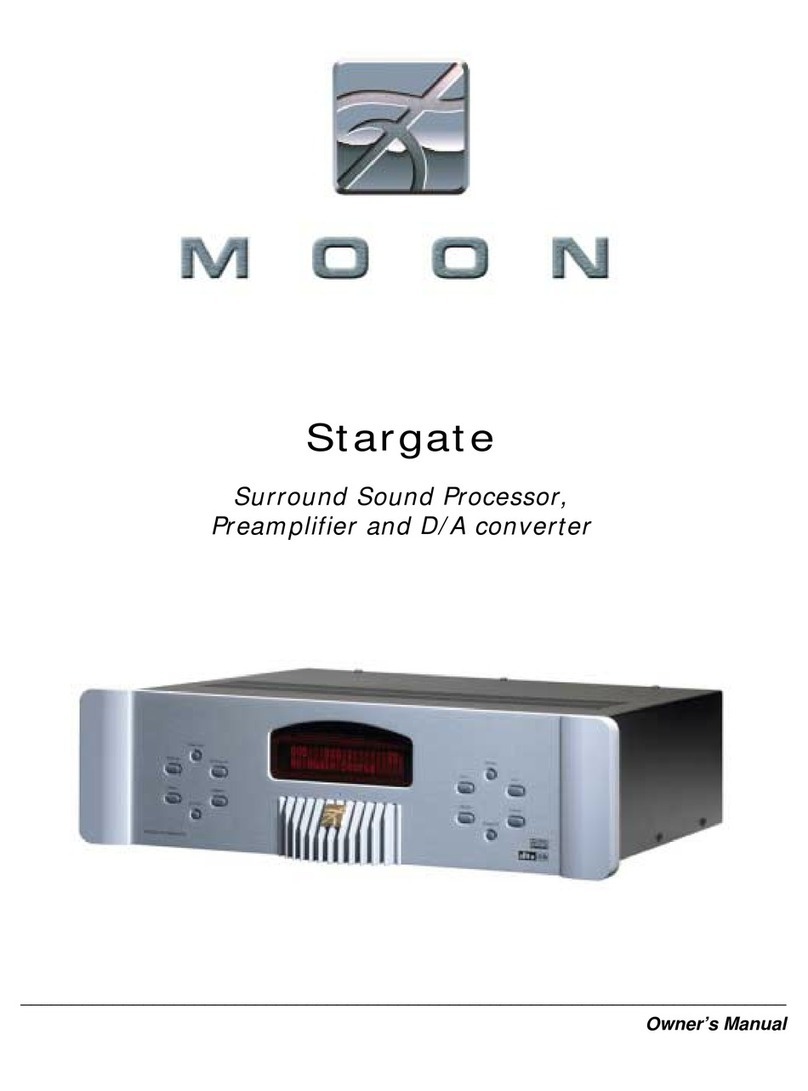AudioArts Engineering D-75 User manual

D-75
Digital Audio Console
TECHNICAL MANUAL
September 2004

R-16 / Dec 1997
D-75 Digital Audio Console Technical Manual - 1st EditionD-75 Digital Audio Console Technical Manual - 1st Edition
D-75 Digital Audio Console Technical Manual - 1st EditionD-75 Digital Audio Console Technical Manual - 1st Edition
D-75 Digital Audio Console Technical Manual - 1st Edition
©2004 Audioarts®Engineering*
AUDIOARTS ENGINEERING
600 Industrial Drive
New Bern, North Carolina 28562
252-638-7000
*a division of Wheatstone Corporation
D-75/ Sep 2004

AA
AA
ATTENTIONTTENTION
TTENTIONTTENTION
TTENTION
RR
RR
READEAD
EADEAD
EAD MM
MM
M
EE
EE
E!!
!!
!
D-75 / Ap 2008
Attention!
FF
FF
Federal Communications Commission (FCC) Complianceederal Communications Commission (FCC) Compliance
ederal Communications Commission (FCC) Complianceederal Communications Commission (FCC) Compliance
ederal Communications Commission (FCC) Compliance
Notice:Notice:
Notice:Notice:
Notice:
Radio FRadio F
Radio FRadio F
Radio Frequency Noticerequency Notice
requency Noticerequency Notice
requency Notice
NOTE:NOTE:
NOTE:NOTE:
NOTE: This equipment has been tested and found to comply with the
limits for a Class A digital device, pursuant to Part 15 of the FCC rules. These
limits are designed to provide reasonable protection against harmful
interference when the equipment is operated in a commercial environment.
This equipment generates, uses, and can radiate radio frequency energy
and, if not installed and used in accordance with the instruction manual,
may cause harmful interference to radio communications. Operation of this
equipment in a residential area is likely to cause harmful interference in
which case the user will be required to correct the interference at his own
expense.
!
This is a Class A product. In a domestic environment, thisThis is a Class A product. In a domestic environment, this
This is a Class A product. In a domestic environment, thisThis is a Class A product. In a domestic environment, this
This is a Class A product. In a domestic environment, this
product may cause radio interference, in which case, theproduct may cause radio interference, in which case, the
product may cause radio interference, in which case, theproduct may cause radio interference, in which case, the
product may cause radio interference, in which case, the
user may be required to take appropriate measures.user may be required to take appropriate measures.
user may be required to take appropriate measures.user may be required to take appropriate measures.
user may be required to take appropriate measures.
This equipment must be installed and wired properly in order to assure
compliance with FCC regulations.
Caution!Caution!
Caution!Caution!
Caution!
Any modifications not expressly approved in writing byAny modifications not expressly approved in writing by
Any modifications not expressly approved in writing byAny modifications not expressly approved in writing by
Any modifications not expressly approved in writing by
Audioarts could void the user's authority to operate this equipment.Audioarts could void the user's authority to operate this equipment.
Audioarts could void the user's authority to operate this equipment.Audioarts could void the user's authority to operate this equipment.
Audioarts could void the user's authority to operate this equipment.

AA
AA
ATTENTIONTTENTION
TTENTIONTTENTION
TTENTION
RR
RR
READEAD
EADEAD
EAD MM
MM
MEE
EE
E!!
!!
!
D-75 / Sep 2004
Attention!
This console contains static sensitive devices:
Normal precautions against static discharge should be observed when
handlingindividualmodules.Inparticular,modulesbeingpackedforshipping
for return or repair must be packed in special static protection bags before
packaging. Damage caused by static discharge may not be covered under
warranty.
Replacing Modules in a Powered-up Console:
While in an emergency situation it is possible to remove and insert modules
on a powered-up console, Wheatstone does not recommend this procedure.
Whenever possible it is best to power down the console first before removing
or replacing modules.
However, if you find you must proceed with this operation, then be sure to
take the following precaution:
When re-inserting a module, take care to replug it squarely into its
mainframe connector socket, so all edgecard fingers make contact
simultaneously. In other words, the gold-plated bus connector fingers on the
bottom edge of the module's printed circuit board must be inserted squarely
(i.e., perpendicular) to the mating socket on the bottom pan of the console
mainframe. The intent is to prevent a situation where one of the module's
power pins makes significant contact before the others. (Naturally, this
same precaution must be taken when using extenders.)
Iftheaboveinstructionsarefollowedtheprocedureshouldberoutine;ifthey
are not, you could run the risk of damaging the console's logic chips.
Again, to avoid ANY possibility of this damage, whenever possible we
stronglyrecommendpoweringdowntheconsolebeforereplacinganymodules.
!

RR
RR
READEAD
EADEAD
EAD MM
MM
M
EE
EE
E!!
!!
!
D-75 / Sep 2004
IMPORTANT!
D-75 AD-75 A
D-75 AD-75 A
D-75 Audio Levelsudio Levels
udio Levelsudio Levels
udio Levels
GeneralGeneral
GeneralGeneral
General
All professional digital audio broadcast consoles manufactured by Wheatstone
are hybrid in nature. That is, they allow the user to connect both analog and
digital domain sources and provide both analog and digital outputs. While this
approach allows for greater flexibility when interconnecting source and
destination equipment, the user must be aware of what levels to expect when
applying, say, a digital input and measuring at an analog output.
Gain StructurGain Structur
Gain StructurGain Structur
Gain Structuree
ee
e
Broadcast consoles by design have various electronic stages at which the
signal level may be amplified or attenuated. The primary stages are the A-D
converter input, channel fader, DSP mixing and the bus output D-A converters.
The sum of these gain stages is commonly referred to as the console’s “gain
structure”. Wheatstone consoles are factory calibrated for 0dB or “unity gain”
when the input channel fader is set to nominal (-12dB).
The following is a stage by stage breakdown of a typical console’s gain stages:
Analog Input (A-D Converter)Analog Input (A-D Converter)
Analog Input (A-D Converter)Analog Input (A-D Converter)
Analog Input (A-D Converter)
•␣ trim pots located on the ADC input circuit cards are trimmed so that a
+4dBU input signal will yield a -20dBFS digital output with the channel fader
at nominal. Trim pot gain range at this stage allows for interfacing unbalanced
equipment. Mic level ADC circuit cards have trim pots for matching various
microphone source levels to the console’s operating level.
DSP GainDSP Gain
DSP GainDSP Gain
DSP Gain
• set in firmware for unity gain, digital attenuation may be applied on a channel
by channel basis via a dipswitch setting.
Analog Bus Output Gain (D-A Converter)Analog Bus Output Gain (D-A Converter)
Analog Bus Output Gain (D-A Converter)Analog Bus Output Gain (D-A Converter)
Analog Bus Output Gain (D-A Converter)
• trim pots located on the corresponding analog output DAC circuit card are
factory trimmed so that a -20dBFS digital input signal will yield a +4dBu
analog output with the channel fader at nominal. These may be adjusted over
a range of -26 to -10dBFS = +4dBu.

RR
RR
READEAD
EADEAD
EAD MM
MM
M
EE
EE
E!!
!!
!
D-75 / Sep 2004
AA
AA
Audio Referudio Refer
udio Referudio Refer
udio Reference Levelsence Levels
ence Levelsence Levels
ence Levels
All consoles are fully factory calibrated and will comply with the following
reference level:
-20dBFS digital = +4dBu analog = 0VU Note: 0dBu = .775v rms
+4dBu = 1.23v rms
These settings will provide a headroom of 20dB over the nominal input signal of
+4dBu analog, or -20dBFS digital. Should your facility require a different
A-D - D-A reference level please consult the factory for calibration details and/
or alternate solutions.
Note that due to the lack of level standards in the digital domain, headroom
available for digital sources will be entirely dependant on the source. In fact, CD's
are frequently made with less than 1dB of digital headroom, and any boosting of
digital CD levels in the console by moving the fader up above the nominal can
result in overload distortion for that channel. For this reason, a dipswitch allows
for digital attenuation on a fader by fader basis; digital sources can be conveniently
attenuated this way to guard against digital overload caused by not enough
headroom on the digital source. Since the D-75 console meters are true digital
reading meters, they will always show the console's digital levels, and whether
there are any "overs" in the signal. By pressing a channel's "CUE" button, the
switched meters will show the digital level of that channel's source, as modified
by the dipswitch setting. By using the program and watching these meters, the
amount of attenuation can be adjusted to meet your headroom requirements.
TT
TT
Typical Input Levelsypical Input Levels
ypical Input Levelsypical Input Levels
ypical Input Levels
Mic Inputs Nominal = -50dBm, 150ΩMaximum = -26dBm
Analog Inputs Nominal = +4dBu Maximum = +24dBu
Digital Inputs Nominal = -20dBFS Maximum = 0dBFS
II
II
IMPORTANTMPORTANT
MPORTANTMPORTANT
MPORTANT

page Contents – 1
D-75 / Sep 2004
CONTENTS
D-75 Technical Manual
Table of Contents
Chapter 1 – Installation and Power
Unpacking the Console ............................................................. 1-2
CountertopMounting................................................................. 1-2
System Ground .......................................................................... 1-3
Power Supply ............................................................................. 1-5
SPS Cable Pinout ................................................................................................... 1-5
Energizing ............................................................................................................... 1-6
Audio and Control Wiring.......................................................... 1-6
ConnectionProcedures .......................................................................................... 1-6
Digital Audio Connections ...................................................................................... 1-6
Unbalanced Connections (analog audio) ............................................................... 1-7
Modules Layout.......................................................................... 1-7
Input Daughter Cards Installation .......................................... 1-7a
Hand Crimp Tool Wiring Insrtuctions ...................................... 1-8
D-75-26 Modules Layout Drawing........................................... 1-10
D-75-18 Modules Layout Drawing........................................... 1-11
Chapter 2 - Quad Mic Preamp (QMP-4)
Overview ..................................................................................... 2-2
Internal Programming Options ................................................. 2-3
Phantom Power ...................................................................................................... 2-3
Hook-ups..................................................................................... 2-3
Audio Input Connections ........................................................................................ 2-3
Audio Output Connections...................................................................................... 2-4
Power Connections................................................................................................. 2-5
Plug Terminal Pinout Drawing .................................................. 2-6
Installing the Optional Second QMP-4 Mic Preamp................ 2-7
D-75 / Nov 2005

page Contents – 2
D-75 / Sep 2004
CONTENTS
Chapter 3 - Stereo Line Input (IN-75)
Module Overview...........................................................................3-2
Internal Programming Options ....................................................3-3
Mutes ........................................................................................................................ 3-3
Tallies........................................................................................................................ 3-3
Timer Restart ............................................................................................................ 3-3
Talkback.................................................................................................................... 3-3
Attenuation................................................................................................................ 3-4
EFS - European Fader Start..................................................................................... 3-4
Hook-ups........................................................................................3-4
Analog Audio Connections ....................................................................................... 3-4
Digital Audio Connections ........................................................................................ 3-5
Control Connections ................................................................................................. 3-5
Remote ON & OFF .............................................................................................. 3-5
Cough .................................................................................................................. 3-5
External START & STOP .................................................................................... 3-6
Ready................................................................................................................... 3-6
Talkback to Control Room................................................................................... 3-6
On Tally ............................................................................................................... 3-6
Tally B .................................................................................................................. 3-6
DB Connector Pinout Drawings
Analog Inputs - ADC-75............................................................................................ 3-7
Digital Inputs - SRC-75............................................................................................. 3-8
Stereo Line Input Signal Flow......................................................3-9
Chapter 4 - Output Module (OM-75)
Module Overview...........................................................................4-2
Internal Programming Options ....................................................4-3
Sampling Frequency for Console Outputs .................................4-3
Hook-ups........................................................................................4-4
Left DB-25 “B” Connector — Digital Audio Outputs, External Analog Inputs .......... 4-4
Right DB-25 “A” Connector — Analog Audio Outputs ............................................. 4-4
DB Connector Pinout Drawing.....................................................4-6
Output Module Signal Flow..........................................................4-7
Chapter 5 - Control Room Module (CR-75)
Module Overview...........................................................................5-2
Internal Programming Options ....................................................5-3
Cue Interrupt............................................................................................................. 5-3
CR/Cue Mute ............................................................................................................ 5-3
On-Air Tally Follows Program................................................................................... 5-3
Hook-ups........................................................................................5-4
Left DB-25 “B” Connector — Audio .......................................................................... 5-4
Right DB-25 “A” Connector — Audio and On-Air Tally ............................................ 5-4

page Contents – 3
D-75 / Sep 2004
CONTENTS
DB Connector Pinout Drawing.....................................................5-5
Control Room Module Signal Flow..............................................5-6
Chapter 6 - Studio Control Module (SC-75)
Module Overview...........................................................................6-2
Internal Programming Options ....................................................6-3
External Talkback Mute/Dim..................................................................................... 6-3
Studio Dim ................................................................................................................ 6-3
Studio Pre Mute ........................................................................................................ 6-3
Hook-ups........................................................................................6-4
Left DB-25 “B” Connector — Audio .......................................................................... 6-4
Right DB-25 “A” Connector — Audio and Tally 2..................................................... 6-4
DB Connector Pinout Drawing.....................................................6-5
Studio Control Module Signal Flow.............................................6-6
Chapter 7 - Superphone Module (SP-75) - optional
Module Overview...........................................................................7-2
Caller Set-Ups .......................................................................................................... 7-2
Automatic Features................................................................................................... 7-3
Inputs and Outputs ................................................................................................... 7-3
Internal Programming Options ....................................................7-3
Cue Pre/Post ............................................................................................................ 7-3
Mutes ........................................................................................................................ 7-3
Timer Restart ............................................................................................................ 7-4
Tallies........................................................................................................................ 7-4
Cue Dropout.............................................................................................................. 7-4
External Input............................................................................................................ 7-4
Gain Trimpots ........................................................................................................... 7-4
Hook-ups........................................................................................7-5
Left DB-25 “B” Connector—Audio & Control............................................................ 7-5
External START & STOP .................................................................................... 7-5
Right DB-25 “A” Connector—Audio.......................................................................... 7-6
DB Connector Pinout Drawing.....................................................7-7
Superphone Input Module Signal Flow.......................................7-8
Chapter 8 - Line Preselect (LS-75) - optional
Module Overview...........................................................................8-2
Internal Programming Options ....................................................8-2
Hook-ups........................................................................................8-3
Left DB-25 “B” Connector — Audio Inputs ............................................................... 8-3
Left DB-25 “B” Connector — Audio Outputs ............................................................ 8-3
Right DB-25 “A” Connector — Audio Inputs............................................................. 8-3
DB Connector Pinout Drawing.....................................................8-5
Line Preselect Module Signal Flow .............................................8-6
D-75 / Jan 2008

page Contents – 4
D-75 / Sep 2004
CONTENTS
Chapter 9 - Tape Remote Module (TR-75) - optional
Module Overview.......................................................................... 9-2
DB Connector Pinout Drawings
START/STOP Function Control I/O.......................................................................... 9-3
Full-Function Control I/O .......................................................................................... 9-4
Chapter 10 - Meterbridge
Overview ..................................................................................... 10-2
Digital Timer ............................................................................... 10-2
Console Clock ............................................................................ 10-3
Controls................................................................................................................... 10-3
Setting the Time...................................................................................................... 10-3
Capacitor Backup ................................................................................................... 10-3
Operational Modes ................................................................................................. 10-3
24 Hour Mode ..................................................................................................... 10-3
External Sync...................................................................................................... 10-4
Dim...................................................................................................................... 10-4
UTIL Pre-Fade / Pre-On Defeat.................................................. 10-4
B Source Logic Options ............................................................ 10-5
External AES Sync Input ........................................................... 10-5
Chapter 11 - Schematics and Load Sheets
Quad Mic Preamp (QMP-4)
schematic................................................................................................................ 11-2
load sheet ............................................................................................................... 11-3
Input Module (IN-75)
schematic................................................................................................................ 11-4
load sheet ............................................................................................................... 11-6
A to D Converter (ADC-75)
schematic................................................................................................................ 11-7
load sheet ............................................................................................................... 11-8
Sample Rate Converter (SRC-75)
schematic................................................................................................................ 11-9
load sheet ............................................................................................................. 11-10
Output Module (OM-75)
schematic.............................................................................................................. 11-11
load sheet ............................................................................................................. 11-14
Control Room Module (CR-75)
schematic.............................................................................................................. 11-15
load sheet ............................................................................................................. 11-19
Studio Control Module (SC-75)
schematic.............................................................................................................. 11-20
load sheet ............................................................................................................. 11-24
D-75 / Nov 2009

page Contents – 5
D-75 / Sep 2004
CONTENTS
Superphone (SP-75)
schematic............................................................................................................ 11-25
load sheet ........................................................................................................... 11-28
Line Select (LS-75)
schematic............................................................................................................ 11-29
load sheet ........................................................................................................... 11-30
Tape Remote (TR-75)
schematic............................................................................................................ 11-31
load sheet ........................................................................................................... 11-32
VU Card (VU-75)
schematic............................................................................................................ 11-33
load sheet ........................................................................................................... 11-35
Mother Board—Right (MBR-75)
schematic............................................................................................................ 11-36
load sheet ........................................................................................................... 11-38
Mother Board—Extender (MBE-75)
schematic............................................................................................................ 11-39
load sheet ........................................................................................................... 11-41
Processor Board (PR-75)
load sheet ........................................................................................................... 11-42
Power Supply (SPS-100)
schematic............................................................................................................ 11-43
load sheet ........................................................................................................... 11-44
Appendix
Replacement Parts List .............................................................A-2
D-75 / Nov 2007

INSTALLATION and POWER
page 1 – 1
D-75 / Sep 2004
Installation and Power
Chapter Contents
Unpacking the Console ............................................................. 1-2
CountertopMounting................................................................. 1-2
System Ground .......................................................................... 1-3
Power Supply ............................................................................. 1-5
SPS Cable Pinout ................................................................................................... 1-5
Energizing ............................................................................................................... 1-6
Audio and Control Wiring.......................................................... 1-6
ConnectionProcedures .......................................................................................... 1-6
Digital Audio Connections ...................................................................................... 1-6
Unbalanced Connections (analog audio) ............................................................... 1-7
Modules Layout.......................................................................... 1-7
Input Daughter Cards Installation .......................................... 1-7a
Hand Crimp Tool Wiring Insrtuctions ...................................... 1-8
D-75-26 Modules Layout Drawing........................................... 1-10
D-75-18 Modules Layout Drawing........................................... 1-11
D-75 / Nov 2005

INSTALLATION and POWER
page 1 – 2
D-75 / Sep 2004
Installation and Power
Unpacking the Console
TheD-75consoleisshippedastwopackages.Onecartoncontainsthe
consoleandtechnicaldocumentation;andtheothercontainstherackmount
power supply, connecting cable, and connector kit.
CountertopMounting
TheD-75audioconsoleisdesignedforcountertopmounting.Console
placementshould avoid proximitytoany electromagnetic fields,suchas
largepowertransformers,motors,andfluorescentlightingfixtures.Ifyou
will be securing the console to the counter top, you may want to pre-drill
the mounting holes (see sketch below).
Set the console in place on the counter, and remove the screws that
hold down the first and the last modules in place (two per module).
Carefully remove those modules from the frame. Attach the console
mainframe to the counter top, using the holes provided in the bottom of
the chassis and screws appropriate to the counter material, and reinstall
the removed modules.
Theconsoleextendsapproximately75/8”abovethecountertopatthe
meterbridge.Thehingedmeterbridgewillrequire14”abovethecountertop
surface and 4 3/4” behind the rear meterbridge to open freely.
Do not connect the D-75 console to its power supply (and do not
connectthepowersupplytotheACpowerline)untilinstructedtodo
so.
NOTE: This console
containsstatic-sensitive
devices. Normal pre-
cautions against static
dischargeshouldbeob-
served when handling
individual modules.
NOTE: Dimensions shown are for 26 position
mainframes; 18 position frames dimensions
shown in ()
40.770 (28.690)
24.180
37.750 (25.670)
17.750
39.270 (27.190)
.760
7.369
(WITHOUT FEET)
7.6341
D = .171"; USE #8
SCREWS
2.356
20.044
.75
0
7.369
(WITHOUT FEET
)
7.6341
D = .171”; USE #8 SCREWS

INSTALLATION and POWER
page 1 – 3
D-75 / Sep 2004
CONSOLE
2-TRACK
MULTI-TRACK
AC BREAKER
BOX
DEVICE 1
DEVICE 2
DEVICE N
CONSOLE POWER SUPPLY
CONTROL ROOM POWER AMP
STUDIO POWER AMP
OTHER
POWER COMPANY
EARTH GROUND
HEAVY
(#4 or #6)
COPPER
WIRE
HIGH POWER
EQUIPMENT RACK
COPPER ROD
SOIL
3-wire ground or separate wire run from chassis
EFFECTS RACK
MIC PANEL
GND
TYPICAL SYSTEM
GROUNDING SCHEME
etc.
3–5 ft.
Tie the console ground lug
terminal strip to the system
earthground. Tieeverypiece
of equipment in the entire
audio system to the console
ground lug terminal strip.
System Ground
The first step is to ground the console.
Note that as supplied from the factory, console rackmount power
supplycommon,audioground,andtheD-75mainframeareconnected
togetherattheconsole,butareNOTconnectedtoelectricalgroundand
the chassis of the power supply. Safety requirements dictate that a
positiveconnectionfromtheconsolemainframetoelectricalgroundbe
made in the completed installation. Use the grounding lug on the rear
of the mainframe to establish your system ground. The grounding lug
may be found at the rear of the console, on the rear frame panel, to the
left if you are looking at the rear of the console.
The system ground serves two important purposes:
(1) It provides a zero signal reference point for the entire audio system;
(2) It assures safety from electrical shock.
Thereexisttwotermsthatoneencountersinadiscussionofground:
(A)EARTHGROUND,whichisusuallyaheavycopperroddrivenintothe
soiladjacenttothebuilding(around6feetdown)oraconnectiontothecopper
water pipes leading into the building. Either is acceptable (unless, of course,
the water pipe is made of plastic).

INSTALLATION and POWER
page 1 – 4
D-75 / Sep 2004
(B) THE POWER COMPANY EARTH CONDUCTOR that enters the build-
ing at the power line breaker box; this conductor should be (and is often by code)
tiedto the above-mentionedearth ground atone point. Thispoint is theSYSTEM
EARTH GROUND.
TIE THE CONSOLE GROUND LUG TO THE SYSTEM EARTH
GROUND. TIE EVERY PIECE OF EQUIPMENT IN THE ENTIRE
AUDIO SYSTEM TO THE CONSOLE GROUND LUG. If the system
earthgroundpoint is inaccessible,tietheconsoleground lug tothepower
company earth conductor at the main breaker box (see drawing "Typical
Grounding Scheme" on previous page).
Each piece of equipment should be connected by its own ground wire
(usually the round third pin on the AC cord). This means that every AC
outlet must have a separate conductor run to the console ground lug; the
outletscannotbedaisy-chainedasisnormallyencounteredincommercial
and residential AC systems. Any equipment not supplied with 3-wire AC
cables must have individual ground wires (16 gauge or larger) connected
to their chassis grounds and then run to the console ground lug terminal
strip.
Further Grounding Details
Check all equipment to be absolutely certain that each unit is power
transformer isolated from the AC mains to prevent safety hazards.
It is assumed that in each piece of audio equipment the audio ground
and the chassis are tied together at some point. Any piece of equipment
lacking a grounded chassis is likely to be prone to interference problems.
Locateallunbalancedaudioequipmentinthesamerackifpossible,to
minimize chassis ground potential differences. It may also be helpful to
insulateeachpieceofunbalancedequipmentfromitsmountingrailsinthe
rackbymeansofnylon10-32screwsandinsulatingwashersbetweenrails
and faceplates.
Once the system is properly grounded, proceed with the console
power supply installation and connection (next section).
D-75 / Nov 2005

page 1 – 5
D-75 / Sep 2004
INSTALLATION AND POWER
Power Supply
The D-75 console is powered by an Audioarts Model SPS-100
rackmount power supply.This unit occupies two 19” wide rack spaces
(total height 3-1/2”). Convection cooled, it requires ample ventilation
space above and below it. The SPS-100 generates heat in the course
of normal operation — do not mount heat sensitive devices in the
same rack cabinet.
Note the power supply should be
mounted in an equipment rack within
fteen feet of the console (but no closer
than 3 feet). Avoid locating any high
gain equipment (such as phono pre-
amps, tape recorders, etc.) too near the
rackmount supplies, to avoid magnetic
interference into that equipment.
Once the supply is rackmounted, it
should be connected to the console using
the factory supplied cable.The cable has
two different types of connectors on it:
an 8-pin female connector that connects
to the console’s power supply connector,
and an 8-pin male connector that plugs
into the rear of the rackmount SPS-100
power supply.The console’s power sup-
ply connector is located at the rear of
the console, toward the left end of the
meterbridge bottom pan when viewed
from the rear of the console.
D-75 / Dec 2012
Front view of the SPS-100
rackmount power supply
Rear view of the SPS-100
rackmount power supply
Console
End
Power Supply
End
1
2
3
4
Phantom
Digital
C
ommon
Digital
C
ommon
+ Digital
NIPNIP
8-pin Connector
Male
Power Supply End
8-pin Connector
Female
Console End
5
6
7
8
+ Digital
Audio
C
ommon
- V
+ V
VIO
GRN
BRN
WHT
ORG
BLK
BLU
RED
PS Cable Pinou
t
1
2
3
4
5
6
7
8
VIO
GRN
BRN
WHT
ORG
BLK
BLU
RED

I N S T A L L A T I O N a nd P OWER
page 1 – 6
D-75 / Sep 2004
Note that the power supply is fitted with a 3-wire grounded AC cord
that should be plugged into a "clean" AC power source, that is, an AC
source that feeds only the control room audio gear. This source should be
a separate feed from those powering lighting, air-conditioning, or any
other non-audio machinery. The third pin ground wire of the AC source
should be tied to the central system ground point.
Energizing
Assuming the D-75 console mainframe is properly placed and grounded,
and its SPS-100 power supply correctly rackmounted and connected to the
console, you may now energize the power supply by plugging it into the
AC mains.
Note: To de-energize the console, unplug the rackmount power supply’s
AC cord from the AC mains. Never de-energize the console by discon-
necting the cable that connects the console and power supply together.
Once you have verified proper power-up, unplug the rackmount power
supply to de-energize the console. You may now proceed to wire up audio
and control connections.
Audio and Control Wiring
All audio and control I/O connections to the D-75 console are made
through multipin DB-25 connectors located on the top of each module.
The factory supplied hand crimping tool is used for all I/O wiring
connections to and from the console (see instruction on the page 1-8).
Connection Procedures
As supplied from the factory, the console requires no logic connections
to function. Therefore an orderly installation begins with the audio wiring.
Note this manual is organized by module type (inputs, outputs, monitor
modules, etc.); each chapter contains detailed wiring instructions for its
module type. Proceed through the manual, chapter by chapter, until all
modules have been wired to suit your particular installation requirements.
Once proper audio operation is verified, go back to each individual chapter
and proceed with control wiring.
Digital Audio Connections
CABLE - All AES/EBU input and output digital audio connections are
balanced and should be made using a high quality digital audio cable. Be
sure to select a digital audio cable with an integral drain wire of the same
wire gauge (AWG) as the twisted pair. Typical AES/EBU digital audio
cable has a very low characteristic capacitance per ft (pF/ft), and a nominal
impedance of 110Ω. High quality digital audio cable offers better signal
transmission performance versus typical analog audio cable, especially
over long cable runs. Check the cable manufactures data sheet to be sure
the cable you plan to use will work in your application.
D-75 / Apr 2008
The power feed recom-
mended in the text is of-
ten installed and referred
to in studios as an “iso-
lated AC ground” outlet.
It is usually orange in
color.

I N S T A L L A T I O N a nd P OWER
page 1 – 7
D-75 / Sep 2004
CONNECTORS - All AES/EBU connections are made with the
supplied DB-25 connectors. These crimp style connectors will accept wire
gauge 24 - 28AWG.
SPDIF INPUTS - The SPDIF (Sony/Phillips Digital Interface) or
“consumer” digital audio interface is a two wire unbalanced signal
typically on a single RCA style connector. We recommend using shielded
twisted pair cables for these connections. Wire the SPDIF center conduc-
tor (HOT) to the SRC-75 “HI” input pin using one wire of the pair and wire
the SPDIF shell (ground) to the SRC-75 “LO” input pin. Connect the
cable’s shield to the SRC-75 “SH” pin, leaving the shield floating (that is,
not connected) at the SPDIF end.
The SRC-75 digital input audio card is provided with 110Ω/75Ω
switches on the A and B inputs to allow impedance matching with 75Ω
sources.
Unbalanced Connections (analog audio)
ANALOG INPUTS — Wire to the console with typical shielded two
conductor cable (like Belden 9451), just as if you were connecting a
balanced source. At the unbalanced source machine’s output, connect the
black wire (LOW) to the shield. If the machine has a -10 dBu output, don’t
hesitate to turn module input gain as high as is needed.
ANALOG OUTPUTS — D-75 consoles use a balanced output circuit
which behaves exactly like the secondary of a high-quality transformer,
with no center tap—this output is both balanced and floating. Either the
HIGH or LOW side of the output should be strapped to ground, with the
output taken from the other side. (Normally you’d strap LOW to ground,
and take HIGH to feed your unbalanced equipment.)
Modules Layout
The D-75 console’s mainframe comes supplied with 20 (for 26 pos.
frame) or 12 (for 18 pos. frame) input modules along with an output
module, a control room module, and a studio control module. Each module
type has its assigned slot (see drawings on pages 1-10 and 1-11). To handle
mic level inputs, a quad mic preamp is included. Also there can be optional
modules: a superphone, a second quad mic preamp, a line preselect, and
a tape remote. Modules must be placed in the slots indicated on the module
layout drawings that follow.

INSTALLATION and POWER
page 1 – 10
D-75 / Sep 2004
Input Daughter Cards Installation
Theconsole’stwodifferenttypesofinputdaughtercards(Figure1)areshippedinaseparate
package, as specified in your order:
•ANALOGADC-75(W#002928)daughtercard;
• DIGITAL SRC-75 (W#002929) daughter card.
These are used to configure the inputs of the
consoleto match thedifferenttypesof signal sources
(analog in, or digital in).
To install console’s daughter cards you must
follow this procedure:
• Make sure the console is powered down.
• Open the meterbridge by simply swinging it up
and back until it rests in a fully opened position
(Figure 2).
• Plug in the daughter card’s edgecard fingers to
theappropriateIN-75 edge connector(Figure3),and
tightenitdownwiththetwosuppliedPhillipsserrated
panhead screws (included in the console’s connector
kit).
Note:Toprovideabettergroundcontact,tighten
downtheserratedscrews,thenunscrewthemalittle
bit and tighten again. This procedure will remove
paint from the face of the daughter card under the
screw head and provide a better metal surface contact.
• Close the meterbridge.
NOTE regarding the SRC-75 digital input daughter card: The SRC-75 has two slide
switchesthatareusedtotogglethedigitalinputimpedancebetween110ohms(forAESinputs)
and75ohms(for SPDIF inputs). SW1affects theB inputandSW2affectstheAinput. Flip the
switchtotheONpositionforaSPDIFinputortotheOFFpositionforanAESinput.Inaddition
tousingtheswitch,theinputmustbewiredcorrectly—seeDigitalAudioConnectionsonpage
1-6 and 1-7. page 1 – 7a
D-75 / Apr 2008
Figure 1. Two types of input daughter cards.
Figure 3. Module edge connector.Figure 2. Open the meterbridge.

INSTALLATION and POWER
page 1 – 8
D-75 / Sep 2004
HAND CRIMP TOOL WIRING INSTRUCTIONS
The supplied hand crimping tool (W/S#850067) is used for all I/O wiring con-
nections to and from the console. It is to be used with the supplied pin (figure 1)
intended for 22"-28" gauge wire.
1) Strip wire approximately 3/16" (insert in
proper wire stripper, rotate one half turn, and
pull insulation off wire).
2) Leaving wire aside for the moment, with
crimping tool fully open (engraved side toward
you) bring a terminal into position from the
unmarked side of the tool. Place the conductor
tabs (inner set as shown in figure 1) on the
"18-22" or "24-30" (depending on the wire) an-
vil (slightly curved surface) so that the circular
portion of the tabs rests in the curved surface
of the anvil and the two tabs face up into the
walls of the female jaw. The insulation tabs will
be flush with the top of the tool (figure 2).
3) Close tool very slightly, only to the point
of holding the terminal in position (figure 2).
4) Insert wire into terminal until wire insu-
lation is stopped by conductor tabs (figure 3).
CRIMP by squeezing handles until jaws are fully
closed (figure 4).
5) If there is an insertion error or if a circuit
change is needed, you'll need to use an extrac-
tor tool to remove terminals (see next page).
Note that metallized plastic hoods for each
connector are also supplied with the console.
(1) Pin crimp terminal
CONDUCTOR
TABS
INSULATION
TABS
INSULATION
STOPS HERE
(2) The terminal conductor tabs (pointing UP) are
placed in anvil 18-22; the terminal's insulation tabs
extend in front towards the camera.
(3) The stripped wire is placed into the terminal and
crimped. Note the wire's insulation must stop just
short of the conductor tabs (detail)
(4) Final step: jaws fully closed; the insulation tabs
have been crimped.
Insulation
stops here
Insulation
stops here
Table of contents
Other AudioArts Engineering Recording Equipment manuals

AudioArts Engineering
AudioArts Engineering R-5 User manual

AudioArts Engineering
AudioArts Engineering R-60 User manual

AudioArts Engineering
AudioArts Engineering D-16 User manual
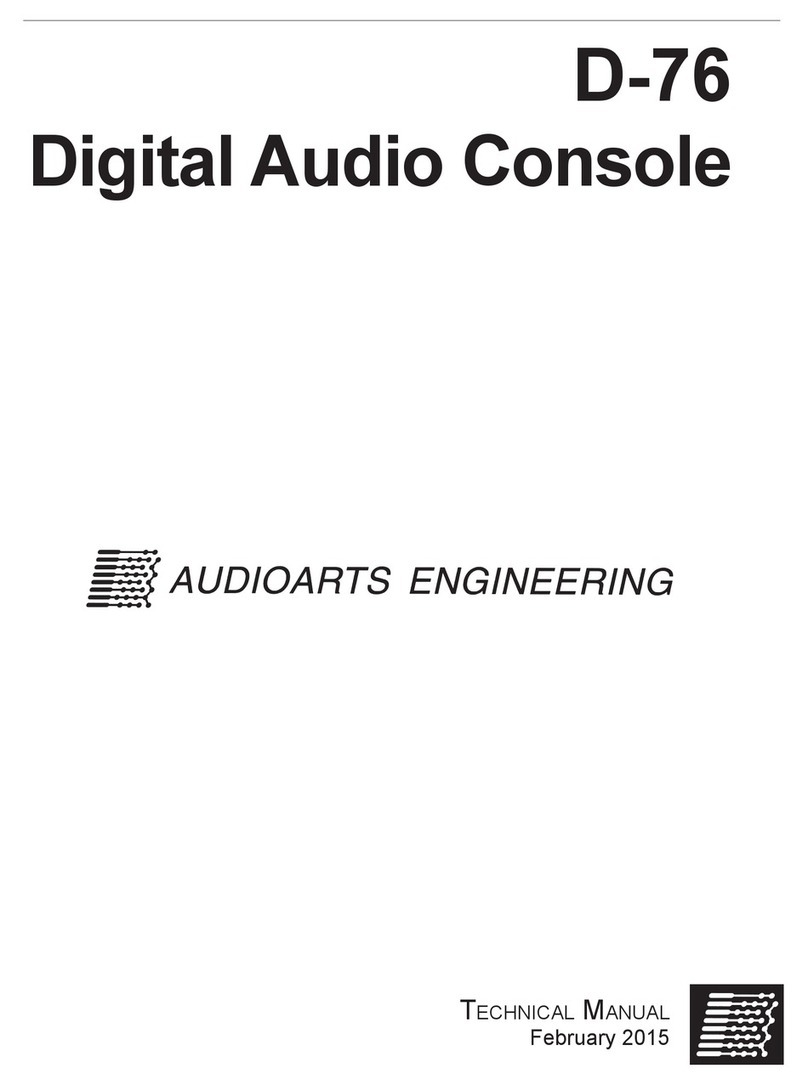
AudioArts Engineering
AudioArts Engineering D-76 User manual
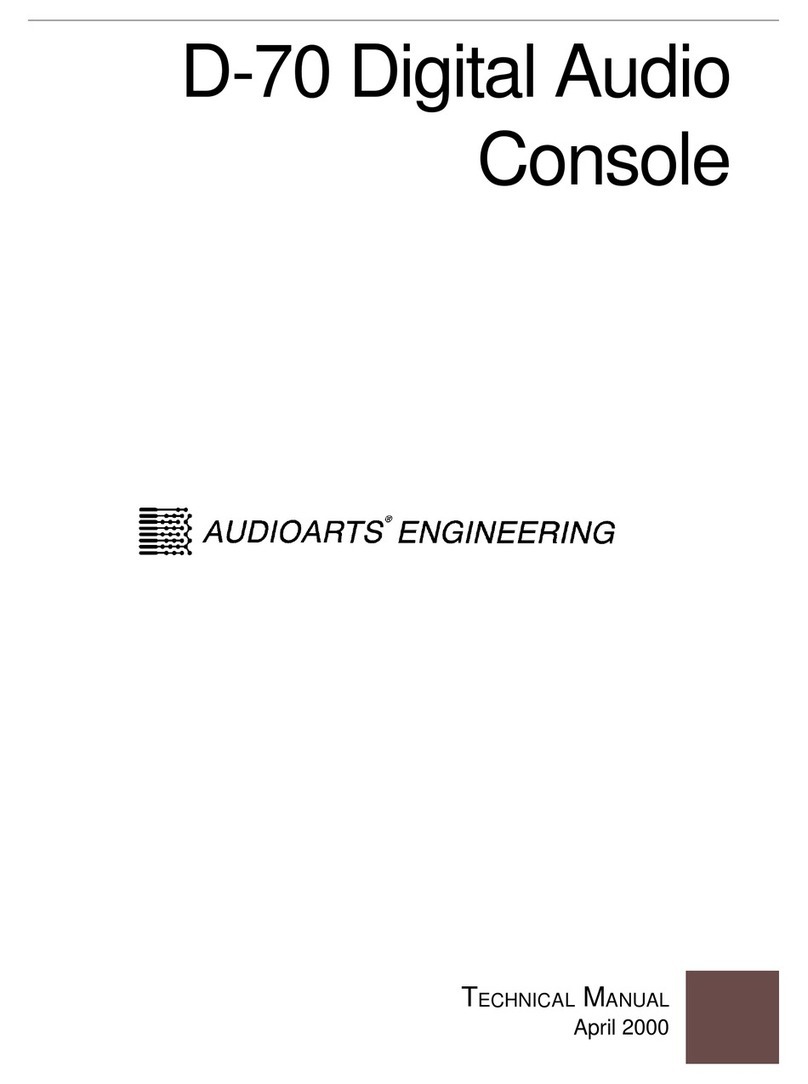
AudioArts Engineering
AudioArts Engineering D-70 User manual
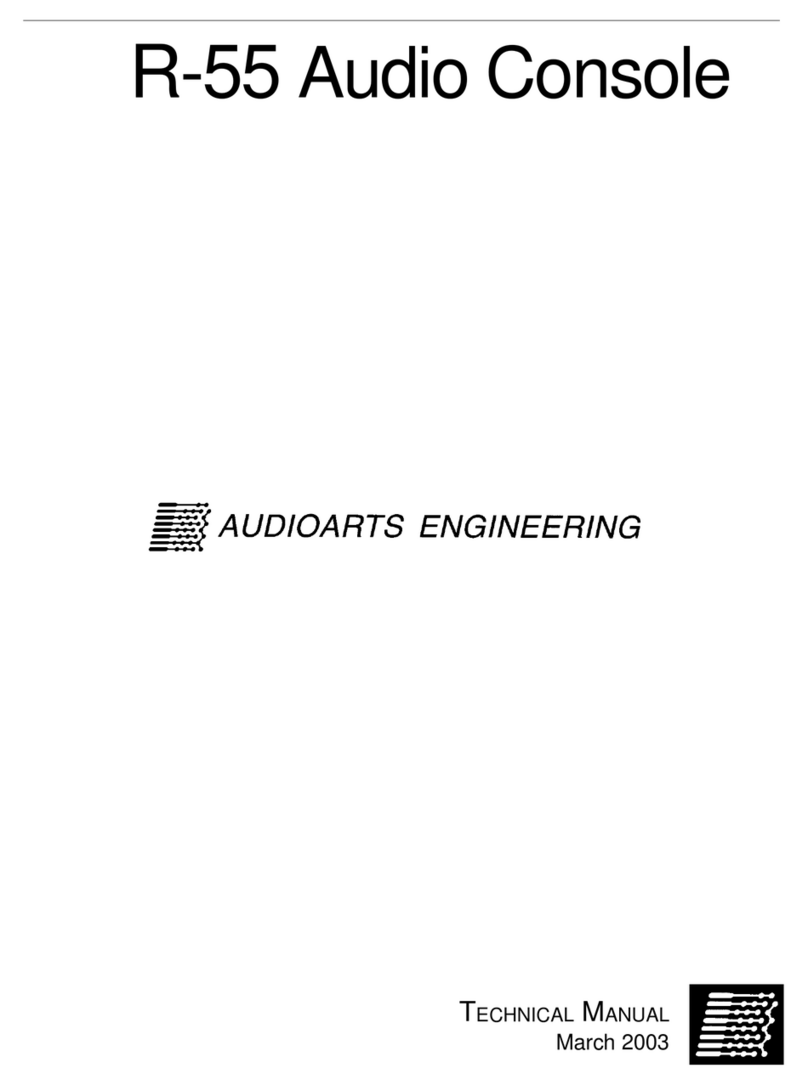
AudioArts Engineering
AudioArts Engineering R-55 User manual


